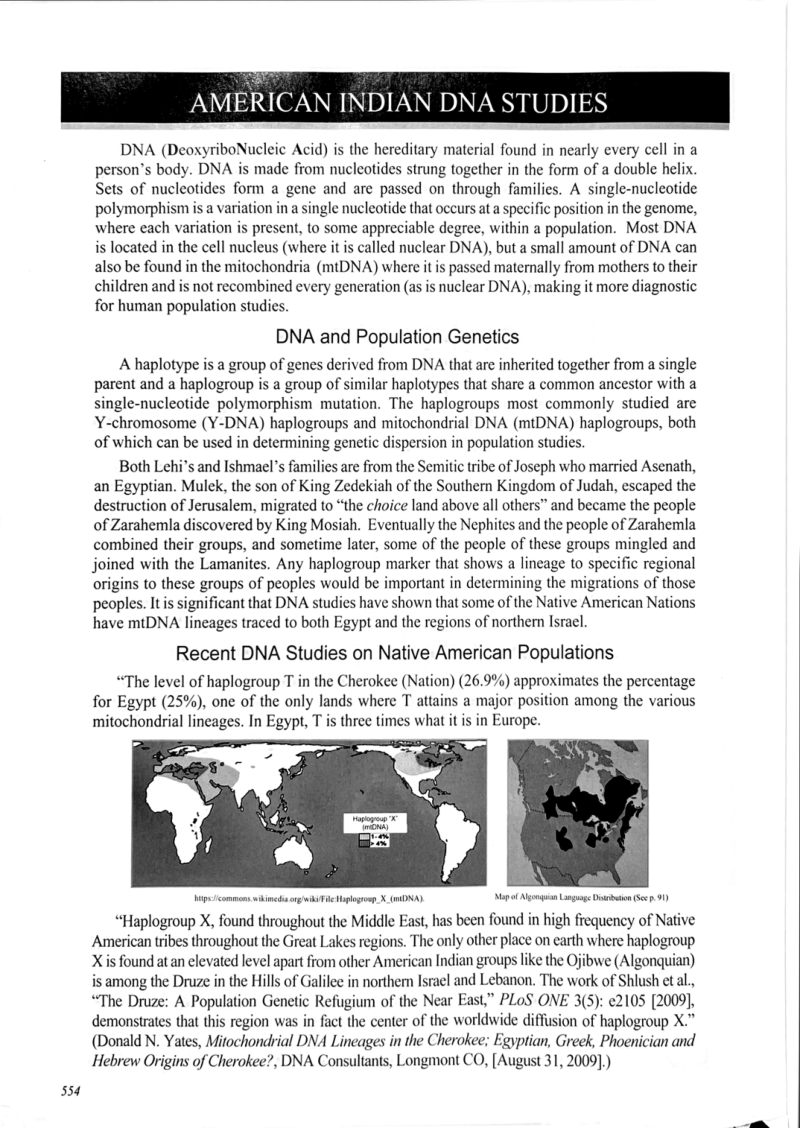David R. Hocking argues that DNA evidence confirms the Heartland model of BOM geography.
- Type
- Book
- Source
- David R. Hocking LDS
- Hearsay
- Direct
- Reference
Annotated Edition of the Book of Mormon, ed. David R. Hocking (Salt Lake City: Digital Legend Press, 2018), 554–555
- Scribe/Publisher
- Digital Legend Press
- People
- David R. Hocking
- Audience
- Reading Public
- Transcription
DNA (Deoxyribo Nucleic Acid) is the hereditary material found in nearly every cell in a person's body. DNA is made from nucleotides strung together in the form of a double helix. Sets of nucleotides form a gene and are passed on through families. A single-nucleotide polymorphism is a variation in a single nucleotide that occurs at a specific position in the genome, where each variation is present, to some appreciable degree, within a population. Most DNA is located in the cell nucleus (where it is called nuclear DNA), but a small amount of DNA can also be found in the mitochondria (mtDNA) where it is passed maternally from mothers to their children and is not recombined every generation (as is nuclear DNA), making it more diagnostic for human population studies.
DNA and Population Genetics
A haplotype is a group of genes derived from DNA that are inherited together from a single parent and a haplogroup is a group of similar haplotypes that share a common ancestor with a single-nucleotide polymorphism mutation. The haplogroups most commonly studied are Y-chromosome (Y-DNA) haplogroups and mitochondrial DNA (mtDNA) haplogroups, both of which can be used in determining genetic dispersion in population studies.
Both Lehi's and Ishmael's families are from the Semitic tribe of Joseph who married Asenath, an Egyptian. Mulek, the son of King Zedekiah of the Southern Kingdom of Judah, escaped the destruction of Jerusalem, migrated to “the choice land above all others" and became the people of Zarahemla discovered by King Mosiah. Eventually the Nephites and the people ofZ arahemla combined their groups, and sometime later, some of the people of these groups mingled and joined with the Lamanites. Any haplogroup marker that shows a lineage to specific regional origins to these groups of peoples would be important in determining the migrations of those peoples. It is significant that DNA studies have shown that some of the Native American Nations have mtDNA lineages traced to both Egypt and the regions of northerm Israel.
Recent DNA Studies on Native American Populations
The level of haplogroup T in the Cherokee (Nation) (26.9%) approximates the percentage for Egypt (25%), one of the only lands where T attains a major position among the various mitochondrial lineages. In Egypt, T is three times what it is in Europe.
"Haplogroup X, found throughout the Middle East, has been found in high frequency of Native American tribes throughout the Great Lakes regions. The only other place on earth where haplogroup X is found at an elevated level apart from other American Indian groups like the Ojibvwe (Algonquian) is among the Druze in the Hills of Galilee in northem Isracl and Lebanon. The work of Shlush et al., "The Druze: A Population Genetic Refugium of the Near East," PLOS ONE 3(5): e2105 [2009), demonstrates that this region was in fact the center of the worldwide diffusion of haplogroup X." (Donald N. Yates, Milochondrial DNA Lineages in the Cherokee; Egyptian, Greek, Phoenician and Hebrew Origins of Cherokee?, DNA Consultants, Longmont CO, [August 31, 2009].)
- Citations in Mormonr Qnas
The B. H. Roberts Foundation is not owned by, operated by, or affiliated with the Church of Jesus Christ of Latter-day Saints.

